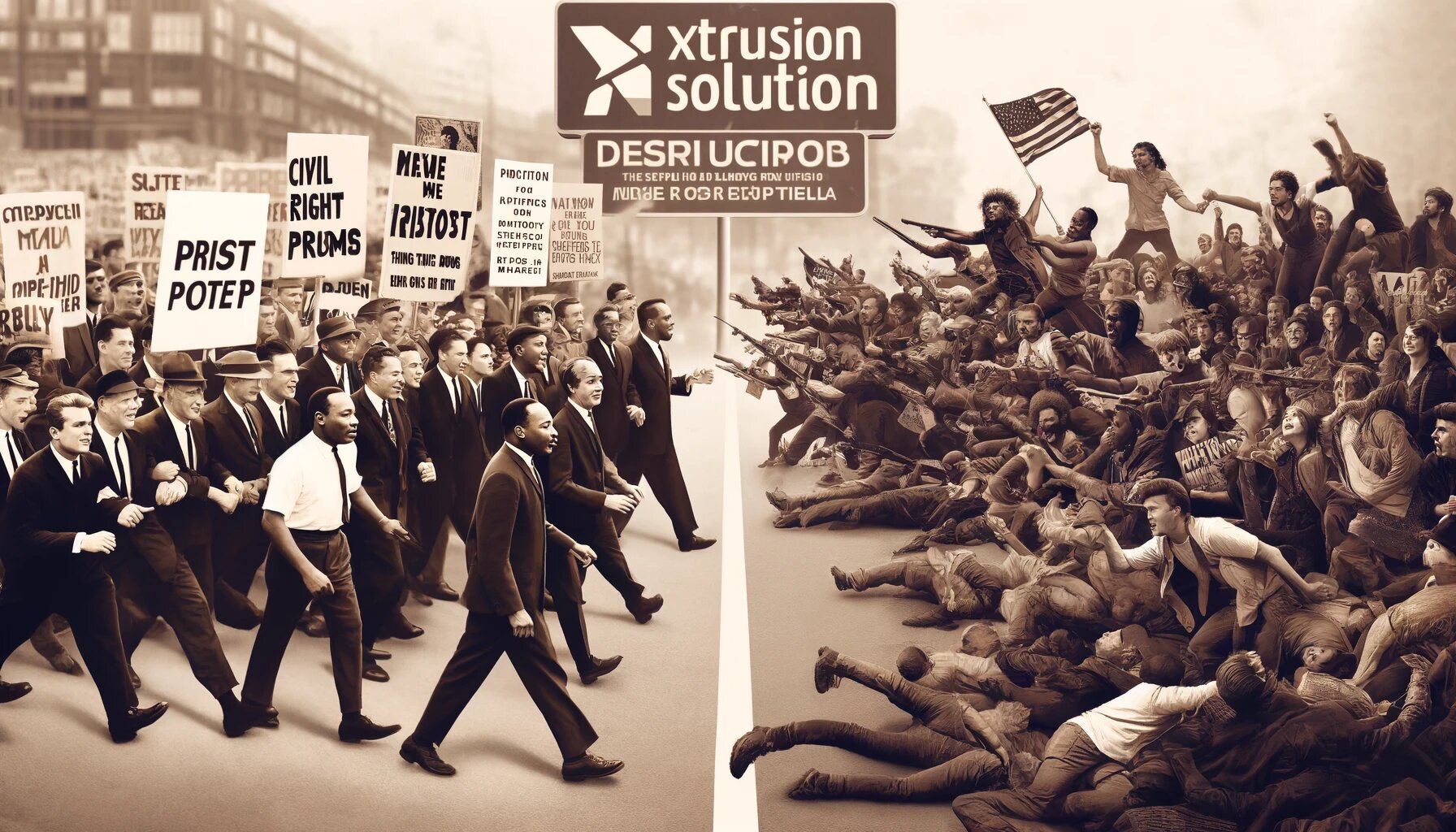Navigating a Changing Landscape of Activism

Explore how the evolution of protest methods have transformed from the peaceful marches of Martin Luther’s era to today’s disruptive roadblocks, and see how these changes reflect broader shifts in activism. Also, discover Xtrusion Solution’s role in shaping the future of advocacy with our revolutionary marketing campaign.
A Dynamic Shift in The Evolution of Protest Methods
Throughout history, the response by government representatives, or lack thereof to respond to a peacefully submitted and justified petition, has often catalyzed more pronounced protest actions. In the 1960s, mere presence in the streets during civil rights demonstrations was sometimes perceived negatively, escalating peaceful actions into confrontations and riots. This cycle of neglect and eventual explosive response continues to influence modern protest methods, shaping how activists today confront and engage with power structures.
Over the years, the methods of protest have dramatically evolved from the organized peaceful marches led by figures like Martin Luther, to current protesters pitching tents on school lawns. Today’s activists often find themselves sitting down in the middle of roads, using disruption to draw attention to their causes. This evolution in protest tactics highlights a shift in how activists engage with societal issues and demand change.
Cultural Climax and Decline

Impacts from The Evolution of Protest Methods
The peak of the civil rights movement in the 1960s reverberated into the 1990s gang wars, affecting not just political landscapes but also cultural expressions such as music and public discourse. Events in Ferguson, the death of Eric Garner, and the murder of George Floyd reignited the necessity for continued activism, underscoring that the fight for justice is far from over. These events remind us that while the methods of protest have evolved, the fervor and urgency behind them are fueled by a continuous struggle for equality.
Author T. Hunter’s Insight on Contemporary Protests
Positioned at a generational crossroads, notes that modern protests ignite passion not only among the youth but also reawaken a commitment among older generations. T. Hunter criticizes the current protest responses that are often driven more by emotion than by strategic and purposeful activism, potentially repeating past mistakes where reactions eclipse reasoned actions.
Understanding Foundations for Advancing The Evolution of Protest Methods
Real comprehension of what drives modern protest methods often comes only after direct personal impact. The existing judicial system, plagued by inefficiencies and corruption, sometimes corners even innocent individuals into accepting unfavorable compromises, perpetuating injustice. This situation calls for a more informed youth and engaged populace who challenge rather than passively accept these flawed systems.
This discussion aims to deepen understanding and foster active participation in advocacy. As college students and others stage protests on various fronts, it’s crucial to acknowledge that meaningful movements start by addressing domestic injustices, not just by responding to international crises.

Genuine movements begin when systemic injustices are ignored, pushing individuals to the edge. Whether it’s political campaigning or advocating for the separation of church and state, the reaction to these movements must be deliberate and well-informed. Actions need to be more than just reactive; they should be based on a profound understanding of the underlying issues.
Join the Movement, Transform the Future
Step forward and be part of something bigger. Support the Xtrusion Solution movement, an initiative born from resilience and a commitment to justice. It’s not just about purchasing a book; it’s about embracing the book of freedom that resonates with your spirit, available now on the XS Managers website. Our founder has faced direct threats—surviving an attempted stabbing and a dangerous encounter at 60 mph—alongside facing systemic opposition from two counties and state governors who have undermined his right to petition the government.
Now, it’s your turn to make a difference. Stop following paths that lead nowhere and start supporting a movement with a proven track record of fighting for change.
Engage and Stay Updated with XS Book Club

But why stop there? Join the XS Book Club and stay engaged with regular updates. As a member, you’ll receive weekly insights into the evolution and cycle of civil rights movements, keeping you informed and connected to our collective advocacy efforts. Each week brings new perspectives, deep dives into activism, and continuous learning opportunities that empower you to be an effective advocate for change.
Sign up today and join a community committed to shaping a better future. Let’s rewrite history together, one page at a time. Join us and become a pivotal part of our ongoing movement.


Comments
3 responses to “The Evolution of Protest Methods”
[…] history of civil rights movement in the United States is a testament to the power of collective action and the determination to […]
[…] and human trafficking, modern protests often lack the focus and gravitas of their predecessors. One major issue is the tendency to protest international issues, such as wars overseas, without addressing pressing […]
[…] and preparedness, qualities that T. Copper instills through the initiatives at Xtrusion Solution. This real-life event is a testament to the fact that real change requires real courage, and sometimes, holding the line […]